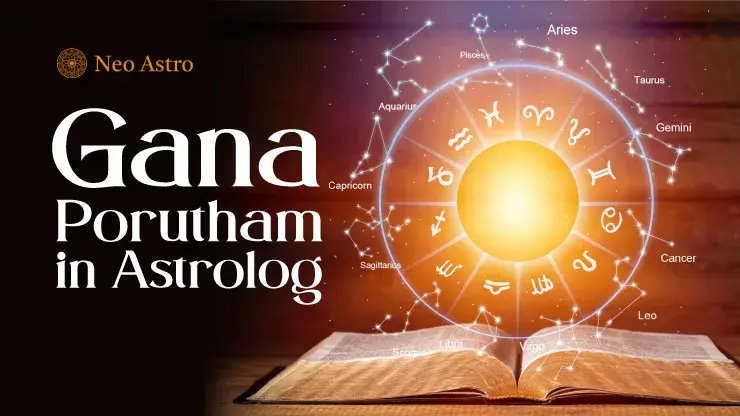Gana in Nakshatra Astrology: How Deva, Manushya and Rakshasa Ganas Shape Compatibility and Spirit

Have you ever wondered why some people feel instantly comfortable with you while others challenge your patience? In astrology, such connections often run deeper than shared interests or temperaments. They trace back to your Nakshatra Gana. This is an ancient classification in Vedic astrology that mirrors your natural disposition, inner energy, and the kind of harmony you share with others.
In Gana in Nakshatra Astrology, every individual is born under a specific Nakshatra that carries one of three distinct Ganas: Deva Gana, Manushya Gana, or Rakshasa Gana. Each of these represents a unique set of qualities, instincts, and spiritual leanings, influencing how we interact with the world and form relationships.
The concept of Gana Porutham, especially in the context of marriage and compatibility, serves as an age-old guide to understanding the subtle chemistry between two souls. Yet, it is more than a matchmaking factor; it is a reflection of human diversity, bridging astrology with spirituality. Let us now understand each Gana in detail. Whether you are curious about your cosmic identity or seeking harmony in relationships, this exploration offers both guidance and introspection through the timeless lens of astrology.
What is Gana or Gana Porutham in Astrology?
In Gana in astrology, the word “Gana” signifies a group, category, or type. It categorises human nature into three spiritual and behavioural archetypes. Based on the lunar Nakshatra at the time of birth, an individual’s temperament and instinctive responses are shaped by their Gana.
Gana Porutham refers to the compatibility aspect of these Ganas in Vedic matchmaking, known as Kundli Milan. It plays a vital role in determining emotional, mental, and spiritual harmony between two partners. Traditionally, this is one of the eight “Koots” considered in the Ashtakoot Milan system and carries a weightage of six points out of thirty-six.
However, Gana Porutham extends beyond marriage charts. It represents how each of us connects, reacts, and evolves through life’s interactions. The classification of Ganas draws from the cosmic order itself, where Devas, Manushyas, and Rakshasas symbolise divine, human, and intense energies respectively.
In essence, Gana Porutham mirrors the diversity of creation. It helps us appreciate that each soul operates from a particular energy pattern, and the alignment or dissonance between these energies can affect personal and spiritual growth.
Understanding The Three Ganas in Nakshatra Astrology
Every Nakshatra aligns with one of three Ganas that define how individuals connect, love, and grow. The Deva Gana embodies purity and kindness, the Manushya Gana represents practicality and emotional depth, while the Rakshasa Gana signifies passion and willpower. Together, they form the essence of human diversity in astrology.
1. Deva Gana (The Divine Nature)
Those born under Deva Gana Nakshatras are believed to embody grace, compassion, and a natural sense of righteousness. Their minds lean towards peace and spiritual purity, making them thoughtful and benevolent in action. Such individuals often possess a gentle strength, they can influence others without dominance and nurture without expectation.
Deva Gana natives are inclined towards service, moral conduct, and spiritual practices. They value harmony over confrontation and find joy in uplifting others. Their emotions are refined, and their sense of empathy allows them to see the good even in difficult situations.
In relationships, Deva Gana individuals thrive with those who respect their calm and idealistic nature. They form compatible unions with Manushya Gana natives, as the combination balances divine idealism with practical wisdom. However, relationships with Rakshasa Gana individuals may demand effort, as their temperaments differ sharply in intensity and outlook.
Nakshatras associated with Deva Gana include Ashwini, Mrigashira, Punarvasu, Pushya, Hasta, Swati, Anuradha, Shravana, and Revati. Each of these carries an essence of purity and devotion, reflecting their celestial influence on the soul.
From a spiritual perspective, Deva Gana signifies the evolution of the heart, the desire to transcend material pursuits and align with truth and compassion. Their challenge lies in maintaining this serenity while navigating human imperfections.
2. Manushya Gana (The Human Nature)
Manushya Gana natives represent the middle path between the divine and the instinctive. They carry both light and shadow, allowing them to experience life through balance. Such individuals are practical, empathetic, and aware of both material and moral responsibilities.
They possess an earthy charm and adaptability that enables them to relate to people from all walks of life. Their strengths lie in moderation, neither too spiritual nor too worldly. This makes them relatable and resilient. However, they can sometimes struggle with indecision, as they constantly weigh idealism against practicality.
Nakshatras belonging to Manushya Gana include Bharani, Rohini, Ardra, Purva Phalguni, Uttara Phalguni, Purva Ashadha, Uttara Ashadha, Purva Bhadrapada, and Uttara Bhadrapada. These nakshatras represent a bridge between aspiration and experience, between divine grace and earthly wisdom.
In relationships, Manushya Gana individuals often make balanced partners. Their moderate temperament allows them to connect easily with Deva Gana individuals, while they may find Rakshasa Gana partners more challenging due to the latter’s intensity and unpredictability.
Spiritually, Manushya Gana represents the stage of self-awareness where one learns through human experiences, love, loss, ambition, and compassion. The lesson for this group is to cultivate inner steadiness and moral clarity amidst the changing waves of life.
3. Rakshasa Gana (The Intense Nature)
Rakshasa Gana individuals are passionate, fearless, and powerful in their convictions. Their energy is transformative, often challenging norms and pushing boundaries. Contrary to misconceptions, Rakshasa does not mean evil; rather, it symbolises raw, untamed energy that can either uplift or disrupt depending on how it is directed.
Those born under this Gana are assertive and independent. They possess a magnetic presence and rarely follow conventional paths. They prefer authenticity over diplomacy and thrive in situations that demand courage and innovation. However, their strong will can sometimes make them appear stubborn or confrontational.
Nakshatras under Rakshasa Gana include Krittika, Ashlesha, Magha, Chitra, Vishakha, Jyeshtha, Mula, Dhanishta, and Shatabhisha. These nakshatras symbolise transformation, strength, and a deep desire for mastery over one’s own destiny.
In relationships, Rakshasa Gana individuals resonate best with partners who can understand their need for independence and intensity. They tend to match well with others of Rakshasa or Manushya Gana, while unions with Deva Gana partners may face friction due to differences in temperament and values.
Spiritually, Rakshasa Gana signifies the evolutionary phase where the soul confronts its inner shadows. It represents the fire of transformation, the urge to transcend limitations and awaken higher consciousness through personal effort and strength.
Gana Porutham in Matchmaking
In Gana in Nakshatra Astrology, Gana Porutham holds a significant place in assessing compatibility between two individuals. It is part of the Ashtakoot Milan system, carrying six points out of the total thirty-six that measure harmony in marriage. Rather than being a rigid score, it reflects how two temperaments align emotionally, mentally, and spiritually. A favourable Gana Porutham symbolises easy understanding and mutual support, while a lower score highlights areas where empathy and communication can bring balance.
Compatibility in Gana in astrology revolves around how the three energies; Deva Gana, Manushya Gana, and Rakshasa Gana, interact. Similar Ganas usually indicate comfort and shared values, whereas differing Ganas invite growth through patience and awareness.
Deva Gana and Manushya Gana pairing often results in a harmonious relationship. The Deva’s gentle and idealistic nature complements the Manushya’s balanced, realistic outlook, fostering mutual care and respect.
Deva Gana and Rakshasa Gana pairing tends to be challenging due to contrasting energies. The divine calm of the Deva may clash with the assertive confidence of the Rakshasa, yet with compassion and emotional maturity, this bond can evolve into mutual strength.
Manushya Gana and Rakshasa Gana pairing can bring together intellect and determination. While differences in temperament exist, they can fuel progress if both partners value each other’s individuality.
Rakshasa Gana with Rakshasa Gana often creates a dynamic relationship marked by intensity and ambition. It thrives when mutual respect tempers dominance and competitiveness.
Deva Gana with Deva Gana reflects a peaceful connection rooted in kindness and shared ideals, though it may lack excitement if both avoid expressing deeper emotions.
When Gana Porutham appears unfavourable, ancient astrology recommends spiritual remedies such as Nakshatra Shanti Puja, mantra recitation, or charitable acts related to one’s birth star. These practices help align energies, reducing emotional friction.
Spiritual Essence of the Three Ganas
Astrology does not label one Gana superior to another. Instead, it reveals the diversity of creation, how each energy contributes uniquely to life’s grand design. When viewed from a spiritual lens, every Gana reflects a particular stage of soul evolution.
Deva Gana: This symbolizes purity of intention and an orientation towards service. Souls in this category are often guided by compassion and a natural inclination towards faith. Their path involves embracing humility while learning to balance detachment with emotional presence.
Manushya Gana: This represents the human quest for balance between spiritual ideals and worldly desires. These individuals learn through experience, discovering wisdom through action. Their journey is one of cultivating discernment and self-awareness in daily life.
Rakshasa Gana embodies transformation: These souls work through the forces of will and passion. They are meant to channel their intensity into creative and spiritual expression rather than domination. Their growth comes from mastering self-control and transforming desire into purpose.
When two people come together, their Ganas interact much like elements in nature. Sometimes they blend smoothly, and sometimes they challenge each other to evolve. From a spiritual standpoint, even challenging matches carry profound lessons, pushing individuals towards self-realisation and deeper compassion.
How to Identify Your Gana?
Determining your Gana in Nakshatra Astrology is a simple yet revealing process that offers clarity about your innate nature and emotional pattern. Your Gana is linked to the Moon’s Nakshatra at the exact moment of your birth. Each Nakshatra aligns with one of the three — Deva Gana, Manushya Gana, or Rakshasa Gana, representing divine, human, or intense energy forms. Knowing this connection allows you to understand how you express love, handle challenges, and respond to life’s rhythms.
Here’s how you can find your Gana:
Step 1: Identify your birth Nakshatra - Consult your Janma Kundali or birth chart, focusing on the Moon’s placement. The Nakshatra in which the Moon resides determines your emotional signature and instinctive nature.
Step 2: Match it to the corresponding Gana - Once you know your Nakshatra, refer to traditional astrological charts to find its Gana classification. For instance, Swati Nakshatra falls under Deva Gana, Rohini belongs to Manushya Gana, and Magha aligns with Rakshasa Gana.
Step 3: Interpret what it reveals about you - Understanding your Gana sheds light on your natural tendencies, whether you seek harmony and virtue like a Deva, balance and practicality like a Manushya, or transformation and strength like a Rakshasa. It explains your emotional reactions and relationship preferences, helping you approach connections with greater awareness.
By recognizing your Gana, you gain insight into your spiritual growth and behavioral patterns. This awareness supports you in making conscious choices in love, career, and self-development, bringing alignment between your inner world and outer expression.
Conclusion
As we wrap up, it becomes clear that Gana Porutham and Nakshatra Gana offer an open a window into emotional awareness and spiritual alignment. Each Gana, whether Deva, Manushya, or Rakshasa, carries its own rhythm, purpose, and beauty. Recognizing yours helps you nurture balance in relationships and understand your path with greater depth.
If you wish to uncover your Nakshatra Gana or explore how Gana Porutham influences your connections, turn to the trusted experts on the Neo Astro app. Their authentic insights bring clarity and meaning to your astrological journey, helping you live with awareness, confidence, and peace.
Nakshatra Gana or Gana Porutham in Astrology - FAQs
What is Gana in Nakshatra Astrology?

In Nakshatra Astrology, Gana refers to a classification system that groups people based on the Moon’s position at birth. Each Nakshatra falls under one of three categories; Deva Gana, Manushya Gana, or Rakshasa Gana. These represent different temperaments and energies, helping explain how individuals express emotions, make decisions, and relate to others.
How important is Gana Porutham in marriage compatibility?

Gana Porutham plays a vital role in Kundli Milan or Vedic matchmaking. It contributes six points out of the total thirty-six in the Ashtakoot Milan chart and helps assess how two individuals connect emotionally and mentally. While a compatible Gana Porutham suggests smoother understanding, a mismatch doesn’t mean failure, it simply highlights areas where awareness and mutual respect can bring harmony.
Can two people with different Ganas have a successful relationship?

Absolutely. Astrology provides insight, not limitation. When two partners belong to different Ganas, they bring unique strengths and lessons to the relationship. For example, a Deva Gana individual may inspire calmness, while a Rakshasa Gana partner can add determination and depth. Success depends on empathy, communication, and shared growth rather than astrological scores alone.
How can I find out which Gana I belong to?

You can identify your Gana by checking your Janma Nakshatra, the lunar star occupied by the Moon at the time of your birth. Once you know your Nakshatra, you can refer to traditional charts that show whether it falls under Deva, Manushya, or Rakshasa Gana.
What happens if Gana Porutham is not favourable in my chart?

An unfavourable Gana Porutham doesn’t mean a relationship will fail. It simply indicates differences that may need extra care. Traditional astrology suggests remedies such as Nakshatra Shanti Puja, charitable acts, or chanting mantras linked to your birth star. Most importantly, awareness, love, and emotional maturity can bridge any astrological gap.
